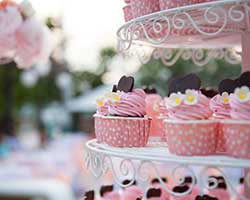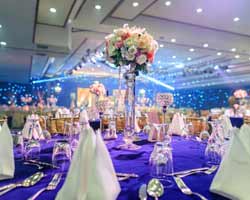NYIAD offers a wedding planning course, and because we do, we often write fun and useful tips for wedding planners. Please enjoy!
If you’re interested in being a wedding planner, think about the many different types of weddings you’ll be asked to coordinate. Some of the weddings will focus on different religious ceremonial customs which may be unfamiliar to you. Some weddings will feature non-traditional male-and-female unions, i.e., same-sex couples. And some weddings will be impacted by divorce, as in the case of second or third marriages or when the bride and/or groom have divorced parents. If you’re not a flexible planner—ready for any contingency—then you might be shutting out a huge potential pool of customers.
- In the picture above, taken by UK photographer Scott Robson, a young couple is making a blessing by pouring flowers from their hands. This Gujarati Hindu Indian wedding contains many customs that will be foreign to wedding planners who have only been exposed to Christian traditions. If you were asked to plan this wedding, what steps should you take? First, always be honest with couples when their traditions are unfamiliar to you. Express your willingness to research these traditions and sit down with them (and their officiate) so you can develop a day-of timeline that will enable you and the wedding party to keep the ceremony and reception running smoothly. Many planners first work as assistants for planners who have non-traditional clientele so they can learn these traditions first hand.
- Have you heard about the florist in Washington state who was sued for refusing to provide flowers for a gay wedding because it violated her religious beliefs? This is one of several such instances involving wedding vendors being sued for not selling goods or services to same-sex couples. As a wedding planner, same-sex ceremonies may not be your specialty, but it can be beneficial to research this market as marriage equality picks up steam throughout the United States and the World. Wedding photographer Thea Dodds, tells us, when working with same-sex clients, “the most important things to do are to ask open-ended and open-minded questions.” Make no assumptions, get an authentic feeling for the couple, and follow their lead. Always assume you’re learning from your clients—because you will be.
- Divorce impacts many families. A good wedding planner exercises sensitivity when dealing with the issues that arise from having clients with divorced and remarried family members, in everything from invitations to seating charts to family photographs. Some divorced couples are comfortable and on good terms with one another, but oftentimes they’re carrying baggage which weighs heavily on the bride and groom. It’s your job to ease your clients’ wedding stress by providing sound solutions for how to avoid tension on their big day. In the case of a second or third wedding ceremony, your job is to help the couple and their families plan a wedding that strikes just the right mood, style, and tone and celebrates their nuptials in a way that they think is most appropriate. It may not be as exuberant as a first-time wedding … but, then again, it might be!
Good wedding planners are flexible, diplomatic, calm under pressure, and very detail oriented. They help a diverse mix of couples realize the wedding of their dreams by assisting them in each stage of the planning process.
Want to learn more? NYIAD now offers an online wedding planning course and an online event planning course.







